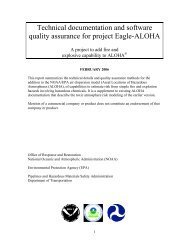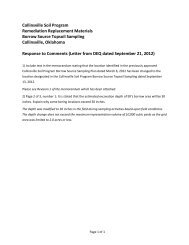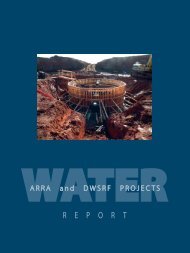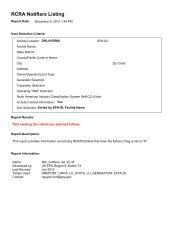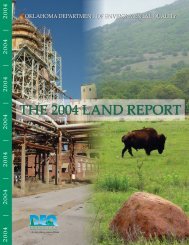Oklahoma Gas & Electric Muskogee Generating Station Best ...
Oklahoma Gas & Electric Muskogee Generating Station Best ...
Oklahoma Gas & Electric Muskogee Generating Station Best ...
Create successful ePaper yourself
Turn your PDF publications into a flip-book with our unique Google optimized e-Paper software.
<strong>Oklahoma</strong> <strong>Gas</strong> & <strong>Electric</strong><br />
<strong>Muskogee</strong> <strong>Generating</strong> <strong>Station</strong> – BART Determination<br />
May 28, 2008<br />
WESP has not been widely used in utility applications, and has only been proposed on<br />
boilers firing high sulfur coals and equipped with SCR. <strong>Muskogee</strong> Units 4 & 5 fire lowsulfur<br />
subbituminous coal. Based on the fuel characteristics listed in Table 4-1, and<br />
assuming 1% SO2 to SO3 conversion in the boiler, potential uncontrolled H2SO4 emissions<br />
from <strong>Muskogee</strong> Units 4 & 5 will only be approximately 5 ppm. This emission rate does<br />
not take into account inherent acid gas removal associated with alkalinity in the<br />
subbituminous coal fly ash. Based on engineering judgment, it is unlikely that a WESP<br />
control system would be needed to mitigate visible sulfuric acid mist emissions from<br />
<strong>Muskogee</strong> Units 4 & 5, even if WFGD control was installed.<br />
WESPs have been proposed to control condensable particulate emissions from boilers<br />
firing a high-sulfur bituminous coal and equipped with SCR and wet FGD. This<br />
combination of coal and control equipment results in relatively high concentrations of<br />
sulfuric acid mist in the flue gas. WESP control systems have not been proposed on units<br />
firing subbituminous coals, and WESP would have no practical application on a<br />
subbituminous-fired units. Therefore, the combination of WFGD+WESP will not be<br />
evaluated further in this BART determination.<br />
Wet FGD Scrubbing - Conclusions<br />
Wet FGD technology is an established SO2 control technology. Wet scrubbing systems<br />
have been designed to utilize various alkaline scrubbing solutions including lime,<br />
limestone, and magnesium-enhanced lime. Wet scrubbing systems may also be designed<br />
with spray tower reactors or reaction vessels (e.g., jet bubbling reactor). Although the flue<br />
gas/reactant contact systems may vary, the chemistry involved in all wet scrubbing systems<br />
is essentially identical. A large majority of the wet FGD systems designed to remove SO2<br />
from existing high-sulfur utility boilers have been designed as wet limestone scrubbers with<br />
spray towers and forced oxidation systems.<br />
Wet scrubbing systems using limestone as the reactant have demonstrated the ability to<br />
achieve control efficiencies of greater than 95% on large pulverized coal-fired boilers firing<br />
high-sulfur bituminous coals. The chemistry of wet scrubbing consists of a complex series<br />
of kinetic and equilibrium-controlled reactions occurring in the gas, liquid and solid phases.<br />
In general, the amount of SO2 removed from the flue gas is governed by the vapor-liquid<br />
equilibrium between SO2 in the flue gas and the absorbent liquid. If no soluble alkaline<br />
species are present in the liquid, the liquid quickly becomes saturated with SO2 and<br />
absorption is limited. 25 Likewise, as the flue gas SO2 concentration goes down, absorption<br />
25 Combustion Fossil Power – A Reference Book on Fuel Burning and Steam Generation, edited by Joseph P.<br />
Singer, Combustion Engineering, Inc., 4 th ed., 1991 (pp. 15-41).<br />
43



